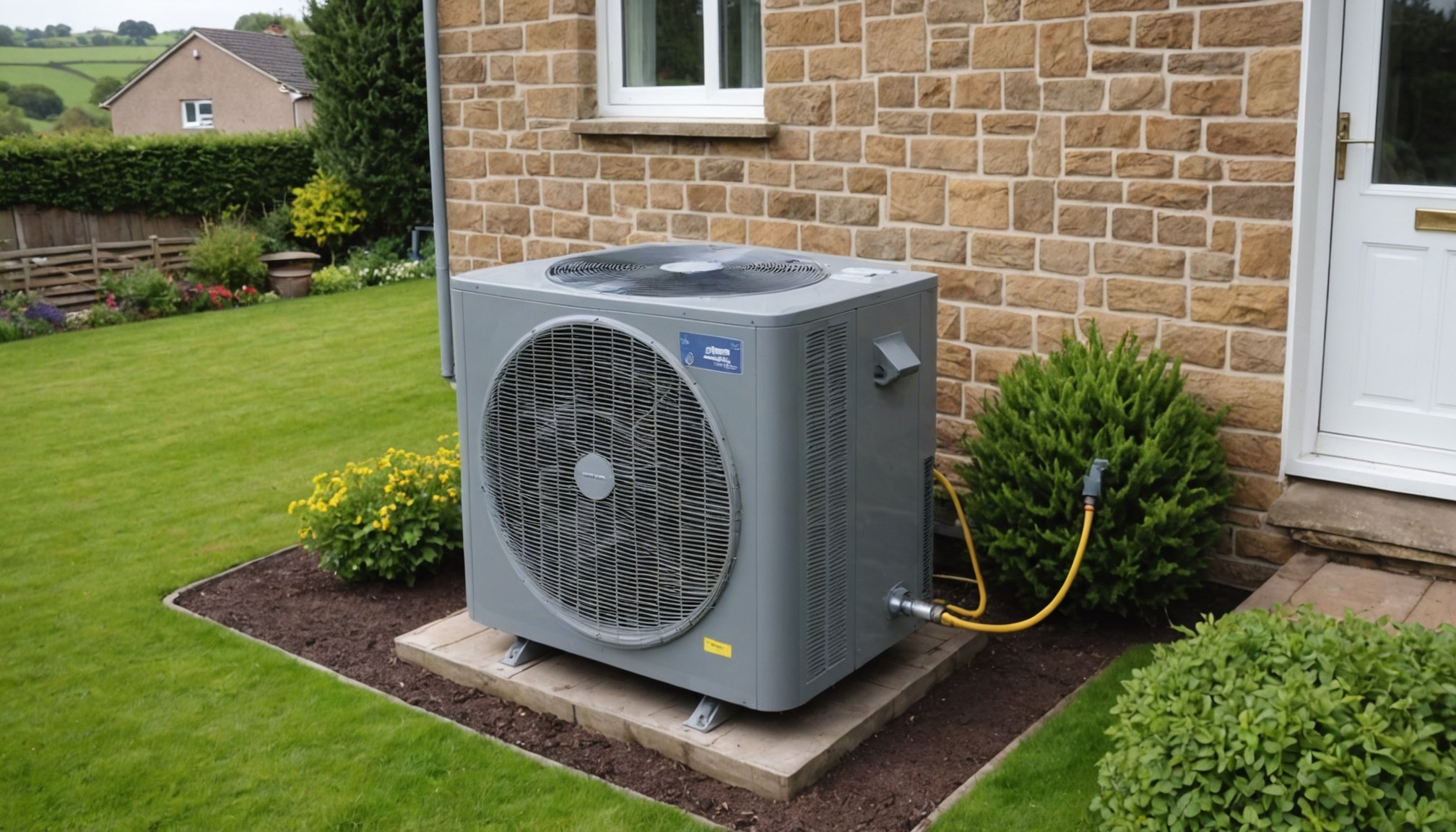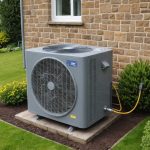Overview of Heat Pumps
Heat pumps are innovative devices that transfer heat from a cooler space to a warmer space using electricity, moving thermal energy in the opposite direction of spontaneous heat transfer. This not only makes them efficient but also eco-friendly by utilising renewable heat sources.
There are several types of heat pumps, each catering to specific needs and environments. The most common include air source, ground source, and water source heat pumps.
Dans le meme genre : Essential Tips for Preserving Your Slate Roof in a Picturesque Welsh Village
-
Air Source Heat Pumps absorb heat from the outside air, which makes them versatile and easier to install.
-
Ground Source Heat Pumps utilise the consistent temperatures found underground for efficient heating, making them ideal for larger outdoor spaces typical of rural areas.
Sujet a lire : The Ultimate Guide to Kid-Safe Paints for Bedrooms in the UK: Choosing the Best Options for Your Child”s Space
-
Water Source Heat Pumps require proximity to a water source but offer high efficiency where conditions allow.
The relevance of energy efficiency in these systems cannot be overstated. Efficient heat pumps significantly reduce energy consumption and greenhouse gas emissions, making them a stellar choice for environmentally conscious homeowners. Adopting heat pumps in rural settings can revolutionize heating solutions by achieving reduced operational costs and enhancing sustainability.
Factors Influencing Heat Pump Installation
When considering heat pump installation, several installation factors must be assessed to ensure effectiveness and efficiency. One crucial aspect is evaluating site conditions and property suitability. A comprehensive site assessment involves understanding the specific areas where the heat pump will operate. This includes the size of the property, current heating systems, and insulation quality.
In rural conditions, unique challenges arise that demand particular attention. Factors such as accessibility, local climate, and energy sources can impact the installation process. Rural environments may face issues like fluctuating outdoor temperatures or limited grid connectivity, which need careful consideration.
A thorough site assessment is essential to address these challenges effectively. This means analysing the physical space for equipment, checking compatibility with existing systems, and considering potential environmental impacts.
Key elements that influence the decision include:
- Local weather patterns and seasonal changes
- Availability and proximity of utilities
- Infrastructure limitations specific to rural areas
By understanding these factors, homeowners can ensure that their heat pump installation is tailored to their environment, providing sustainable and efficient heating solutions. Conducting a detailed site assessment minimizes potential issues and enhances long-term functionality.
Regulatory Requirements for Installation
Navigating the regulations, permits, and legal considerations is crucial when planning installations. Firstly, getting acquainted with local regulations and planning permissions can prevent future headaches. Different regions have unique standards, and ensuring compliance from the start saves time and stress. This is especially crucial when dealing with constructions that may affect neighbouring properties or public spaces.
The importance of aligning your plans with building codes cannot be overstated. These codes are established to guarantee safety, functionality, and uniformity across all structures. Non-compliance could result in fines, legal disputes, or even orders for removal of the installed structures. Always prioritize understanding and meeting these standards; it will be both a legal safeguard and a reassurance in your construction process.
The steps to obtaining necessary permissions typically include initial consultations with local authorities, submission of detailed project plans, and potentially some public notifications or surveys. Depending on the complexity of your project, you may also need to engage with consulting engineers or architects. By thoroughly preparing and submitting all required documentation, this process can not only be streamlined but also instil confidence in stakeholders, knowing all legal considerations have been appropriately addressed.
Installation Process
When faced with the task of setting up a robot hoover, understanding the installation process is crucial. Homeowners often grapple with the decision between hiring professional services or opting for a DIY approach. To ensure a seamless setup, let’s delve into each step meticulously.
First, refer to the manufacturer’s instructions to unpack and inspect your unit. Make sure all components are present and damage-free. For those considering DIY, clear space where the station will reside, ensuring proximity to a power outlet and away from foot traffic.
However, if you’re inclined to seek professional assistance, there are clear benefits. Professionals may offer the advantage of experience and efficiency in navigating potential obstacles such as connectivity issues or tricky layout configurations. Their expertise often leads to more optimally configured devices, tailored to your home’s specific needs.
If choosing a contractor, it’s wise to vet service providers. Review past work and customer testimonials, inquire about warranties, and confirm pricing transparently. Ultimately, whether installing independently or enlisting professionals, being well-informed will aid in a successful and stress-free integration of your new device into your home’s ecosystem.
Cost Implications
When considering the cost of installation for heat pump systems, several factors come into play. The initial installation costs can vary depending on the size of your home and the type of heat pump chosen. On average, these costs can range widely, often requiring a significant upfront investment. However, the financial outlook improves when we consider the long-term benefits these systems offer.
One of the key financial considerations is the reduced energy bills seen over time. Heat pumps are highly efficient, leading to lower operational costs and significant savings on heating expenses. In areas where traditional fuel prices are high, the switch can be even more beneficial.
To aid in offsetting the initial installation costs, grants and incentives are frequently available, particularly for rural installations. These programs are designed to encourage the adoption of sustainable energy solutions, easing the financial burden on homeowners. Exploring these options can be a strategic move, as they can significantly lower the upfront costs and make the switch to heat pump systems more financially attractive. By taking advantage of local and national incentives, homeowners can further enhance the cost-effectiveness of their investment.
Climate Considerations in Rural Scotland
Understanding the climate impact on heat pump performance is crucial, especially in rural Scotland where conditions vary significantly. The local regional weather directly influences the efficiency of these systems; thus, it is important to select the appropriate technology based on specific climatic conditions.
Heating efficiency can fluctuate across different Scottish regions. For instance, the western coastal areas, known for milder and wetter conditions, might see a different performance level compared to the colder and dryer Highlands. The efficiency of a heat pump is affected by the outdoor temperature: the colder it gets, the harder the system works, impacting performance.
Optimising heat pump performance in varying climates requires some strategic measures:
- Choose a heat pump designed for low-temperature operations if living in colder regions.
- Ensure the system is professionally installed and regularly maintained to maximise its efficiency.
- Incorporate additional insulation in homes to enhance overall heating efficiency.
By considering the regional weather and tailoring the heat pump installation to these conditions, homeowners in rural Scotland can achieve better climate impact management and maximise their system’s efficiency. Understanding local climate factors ensures optimal performance throughout the year.
Benefits of Heat Pumps in Rural Areas
Heat pumps offer numerous advantages in rural settings, primarily driven by their positive environmental impact and potential for significant energy savings. These systems harness renewable energy sources, reducing dependence on traditional fossil fuels, thus contributing substantially to the reduction of carbon footprints. By replacing conventional heating methods, heat pumps decrease the emission of harmful gases, paving the way for a more sustainable future.
The energy efficiency of heat pumps is particularly beneficial in rural households, where access to diverse energy sources might be limited. They can operate at a fraction of the cost compared to traditional heating systems, leading to substantial financial savings over time. With lower energy consumption, they also play a pivotal role in conserving resources, making them an economically sound choice for residents in these areas.
Moreover, the integration of heat pumps supports broader sustainability efforts, aligning with global agendas to mitigate climate change. Adopting significant strategies like heat pumps in rural communities exemplifies a forward-thinking approach, demonstrating the collective potential to innovate and reduce our environmental impact. Enabling settings integrating these systems encourages energy independence, reinforcing the advantages of heat pumps in creating resilient and eco-friendly communities.
Challenges and Limitations
When considering heat pumps for your home, it’s crucial to understand the challenges they may present, especially regarding installation difficulties. In rural areas, these challenges can become particularly acute due to less accessible infrastructure. For instance, installing a heat pump may demand specialised equipment and knowledge that aren’t readily available locally. Additionally, logistical hurdles can lead to increased expenses and delays.
Extreme weather conditions pose significant limitations for heat pumps. While they excel in moderate climates, their efficiency can drop dramatically in extremely cold temperatures. This is due to the technology’s reliance on drawing heat from the surrounding environment, which becomes challenging when the outside temperature falls significantly. As such, supplementary heating systems may be necessary during the coldest months, which can raise both installation and operational costs.
Maintenance is another area to consider. Regular upkeep is vital for ensuring the longevity and optimal performance of heat pumps. This includes tasks like cleaning filters, checking for refrigerant leaks, and ensuring that the system’s components are functioning efficiently. Scheduling routine maintenance can help avert more severe issues but may require professional services, further adding to the system’s lifetime costs. Understanding these maintenance requirements can help homeowners plan effectively for the future care of their heat pump systems.
Expert Tips for Successful Installation
When setting up a heat pump system, several expert advice points should guide your process. Firstly, a comprehensive installation checklist ensures no crucial element is missed. This list typically includes confirming the appropriate size of the heat pump for your space, verifying compatibility with existing infrastructure, and ensuring adequate ventilation is available.
Installation tips stress the significance of selecting the right location for the outdoor unit. It should be placed on a stable surface, away from potential obstructions, and sheltered from severe weather conditions. Best practices also involve assessing the insulation in your building to maximise efficiency, as losing heat through poor insulation can reduce a pump’s effectiveness.
Moving on to monitoring, experts recommend installing a reliable system to track performance metrics. This includes using smart thermostats or specialised monitoring software that connects to your smartphone. Regular checks can help detect issues early, ensuring your system maintains optimal function.
Finally, learning from insights shared by industry experts, they often advise on the importance of professional consultation during any installation. Engaging with experts not only provides peace of mind but ensures that the system operates efficiently and reliably, aligning with long-term energy-saving goals.
Case Studies from Rural Scotland
In rural Scotland, heat pump installations offer insightful case studies, providing real-life examples of energy transformation in remote communities. Through these installations, residents have made strides in reducing energy consumption while also embracing sustainable practices. One community experience indicates an impressive energy use reduction, as a family saw a 30% decrease in their electricity bills after switching to a heat pump system.
A detailed analysis reveals several factors that contribute to successful installations. The size and insulation of homes significantly impact the efficiency of heat pumps, and understanding local climate conditions is crucial. The lessons learned highlight the importance of tailored solutions for each household.
The impact of heat pumps in these rural areas extends beyond energy savings. Residents report increased comfort levels in their homes due to more consistent heating. Moreover, communities have witnessed a ripple effect, with successful installations encouraging wider adoption of this technology.
Overall, these case studies illustrate the potential and challenges of heat pump installations in rural settings. They serve as tangible examples of how communities can modernise their energy use, promoting environmental sustainability while benefiting from reduced costs and enhanced living conditions.











